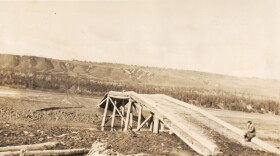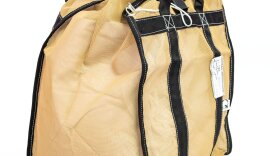The University of Alaska’s Red Meat Center in Homer is a glimpse into a much larger piece politics and education in Alaska. I learned my lesson in mentioning something without giving it enough reference in my recent story about Homer’s Winter Carnival parade. This is going to be a tough story to cut into a short community piece for KBBI, but I’ll try. The two folks I talked to directly were local Otto Kilcher and former manager of the Center, An Peischel. An contacted KBBI directly offering to provide more information. Where I found the most information and to put the Homer Center in a larger context, if anyone else wants to learn more, was through an old, web reformatted newsletter (Agroborealis) document from the University’s Agriculture and Forestry Experiment station from 1998.
The newsletter gives the basic history of these agricultural experiment stations established in different regions around the state of Alaska: “In 1862, President Abraham Lincoln signed into law the Morrill Act establishing land-grant colleges in the United States and its territories to provide education in the science and economics of agriculture. This initiated the?system of agricultural experiment stations to provide science-based research information for farmers and which eventually became part of the land-grant college in each state. While Alaska did not become a state until 1959, Territorial Governor John Strong accepted the federal land grant in 1917. This led to the establishment of the Alaska Agricultural College and School of Mines in Fairbanks in 1922. The college became the University of Alaska in 1935.”
The Homer station opened in 1978 and only remained open for 10 years. When I spoke with Otto Kilcher, he also backs me up to say that the Homer center was part of a larger project. In his words, “the government was providing huge amounts of money to spawn an aggressive agricultural element in the state.” There was some early state politics involved with the Homer site, too.
The Homer facility, located out East End Road by Fritz Creek and possibly 1000 acres in size, was mostly for cattle. It included a Main house, ranch hand/ guest house, tractor shed, barn, scales, an experimental building, pens for maternal cows, pens for steers. Kilcher talked about some of the experiments, such as, “can you feed a cow straight urea?”
But there were some features that created some conflict. For example, the organization never built a slaughter facility and there was never enough infrastructure created to get feed to the animals. There wasn’t quite enough local crop available, the grain was mostly trucked down from the Delta grain fields. So, there were challenges to the operational aspects. Another issue, in Kilcher’s opinion, was that many of the original functional and technical plans for the facility didn’t take into consideration features of the land and climate that may have been an oversite by politicians and agricultural opinions that were not local. Site selection, he says, was chosen by what “looked good from the air.” “It was put together by bureaucrats and photographs.” The landscape features didn’t provide what was hoped for. The center in Homer lasted 10 years before it kind of fell apart. Kilcher’s assessment: “It was a noble attempt to jump start agriculture, but the scale of economics was a little out of hand. It was a little too much external federal/ government effort to “tell us how to do it.”
An Peischel is the second person I spoke to. She was very involved. But, before I explain that, one side comment. Let me express that it’s fascinating that a woman who runs a goat livestock facility in Nashville, Tennessee who doesn’t have enough personal technology to connect to a Zoom meeting with me was still able to find me, share the story and get an interview recorded and transcribed by phone with a few hours of effort. That is an impressive component of public radio.
Pieschel tells me how the Homer project began, “Well, the Homer facility was created with a grant from the State of Alaska to the Kenai Peninsula Borough and the University of Alaska. It was started because there were some ranchers in the Homer area and they wanted to do some beef cattle research. It also had to do with the Delta barley project. Also, there was a fellow in Homer (Bill Mitchell) who was a “grass man” and he had some experience with anglo-Tennessee grass. There were a couple hay field sites in town, one up on Look Out Mountain, one out on Greer Road. The cattle lived up on Look Out in the summer and then feed-lotted them on Delta barley in the winter and then they were slaughtered and sold to the public.”
After the introduction, I can’t help but ask, “how did you get involved? What’s your story?” Peischel is originally from Pennsylvania, received a PhD from Kansas State in “Range Livestock Nutrition.” “I have a PhD in hogs,” she explains. An advisor from “K State” suggested she apply, she did and was hired as director.
She talks more about the start of the facility, “we built a lot of our buildings, cut and processed our lumber with a company called “Small Potatoes,” the house building was already there, the barn was there. There was a small fire house on the property that we turned into a slaughter house. “I also worked with the commercial fisheries and agriculture bank in Anchorage and got a couple of grants from them to help with the barley. Other employees were stockman, a mechanic and a carpenter who were all living in the Homer area at that time.
Compared to the other stations in the state, the Homer site only lasted about 10 years. An’s analysis: the short term breakdown was a result of lack of funding and shortage of effort because the facility was competing in a community era with so much going on in commercial fisheries. An tells me she used to “give some of the local fishermen heads and hides to put in their crab pots.”
This isn’t the end of the story; there are still farm facilities affiliated with what the Center offered. But, it gave me an introduction to an industry I liked hearing more about.

Play Live Radio
Next Up:
0:00
0:00
Available On Air Stations



